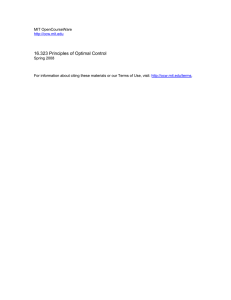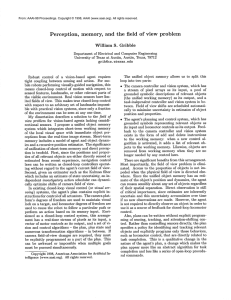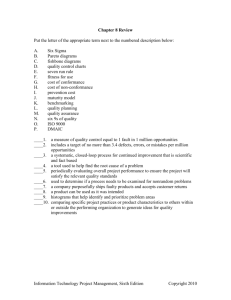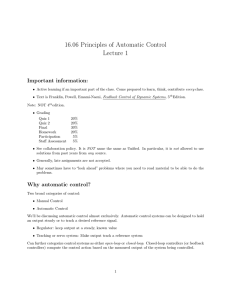Analysis of a closed-loop feedback system
advertisement
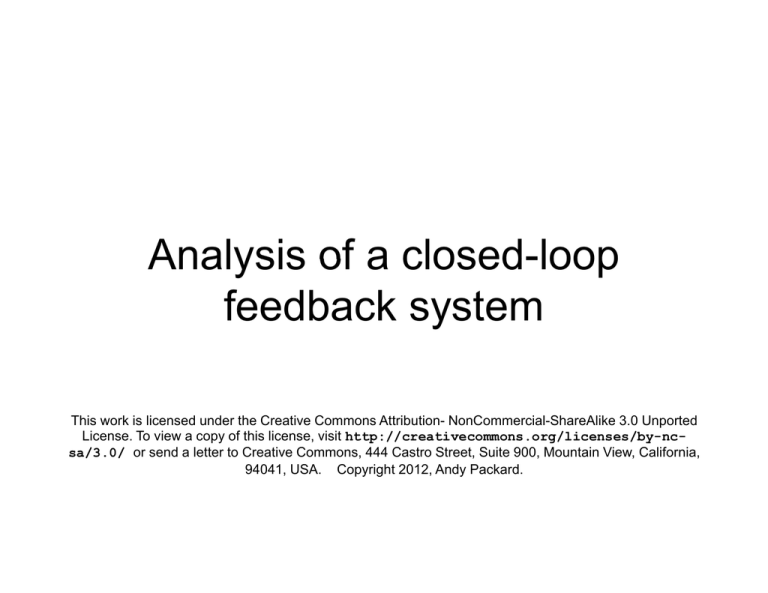
Analysis of a closed-loop feedback system This work is licensed under the Creative Commons Attribution- NonCommercial-ShareAlike 3.0 Unported License. To view a copy of this license, visit http://creativecommons.org/licenses/by-ncsa/3.0/ or send a letter to Creative Commons, 444 Castro Street, Suite 900, Mountain View, California, 94041, USA. Copyright 2012, Andy Packard. Complete Analysis of simple feedback system #2 Return to our basic block diagram which motivated feedback control, and make enough h simplifying i lif i assumptions ti so th thatt th the closed-loop l dl system t iis governed db by a single, linear differential equation (which we can completely analyze). d y r P u K ym x u + 1st + order controller x (t ) ax(t ) b1r (t ) b2 ym (t ) u (t ) cx(t ) d1r (t ) n y (t ) u (t ) d (t ) Constant-gain, non-dynamic plant Eliminate u, yM x (t ) a b2 c x(t ) b1 b2 d1 r (t ) b2 d (t ) b2 n(t ) y (t ) cx(t ) d1r (t ) d (t ) 0n(t ) u (t ) cx(t ) d1r (t ) 0d (t ) 0n(t ) 1st order closed-loop system Complete Analysis of simple feedback system #2 Facts: (we know these) ▫ Closed-loop system is stable if and only if a b2 c 0 ▫ (if stable) time-constant is Some Closed-Loop FRFs d r ym K x y P u u + 1 a b2 c + n Closed-loop steady-state gains Obtaining Obt i i iintegral t l control t l as a necessary condition to specifications This work is licensed under the Creative Commons Attribution- NonCommercial-ShareAlike 3.0 Unported License. To view a copy of this license, visit http://creativecommons.org/licenses/by-ncsa/3.0/ or send a letter to Creative Commons, 444 Castro Street, Suite 900, Mountain View, California, 94041, USA. Copyright 2012, Andy Packard. Closed-loop properties and design objectives Stable if and only if Time-constant r ym Steady-state gains d K x y P u u + Design Objective: ▫ SSGd→y=0 choose a=0, which simplifies SSGr→y to… ▫ SSGr→y=1 choose -b1=b2 All FRFs, b1 and b2 just multiply c (nowhere else) so: b1=-b2=1 ▫ Stability y and desired time-constant Choose c such that: + n Closed-loop properties and design objectives Design choices d r ym Controller form becomes K y P u u x + + n with d1 still free (specifications have not lead to any restrictions on d1). ) Block diagram of controller is: r ym r ym u - u - For simplicity, take d1=0, and notate the gain simply as KI Closed-loop properties and design objectives Specifications ▫ SSGd→y=0 ▫ SSGr→y=1 leads to the architecture r ym d r K ym x y P u u + u + - The equation governing u, ie., the strategy, is simply “change u, with rate based on the mismatch between r and ym” Contrast this to the proportional strategy, “set the value of u based on the values l off r and d ym” New strategy is an “integral” strategy, usually called integral control. n Closed-loop properties and design objectives Design choices are Plant parameters likely uncertain. Stability: y Time Constant: are Governing equations: Closed-loop FRFs Probably should plot these, to get some insight, for different values of the 4 parameters… Steady-state gains: Instantaneous gains: Closed-loop properties and design objectives Steady-State Gains: open loop improvement closed loop closed-loop Keeping track of the effect of n shows the tradeoff: open loop Role of accurate sensor closed loop In the context of a cruise cruise-control control system: Vehicle speed sensitivity is moved from (d) geography/hills which hi h are external, t l tto ((n)) speedometer which is a component in the system Time-Delay “margin” What is the smallest T>0 such that the closed-loop system is unstable? Stability (in linear equations) determined solely by free-response Check this

